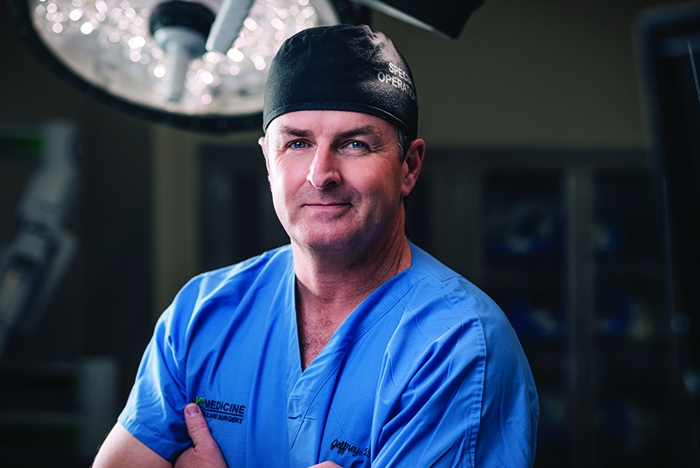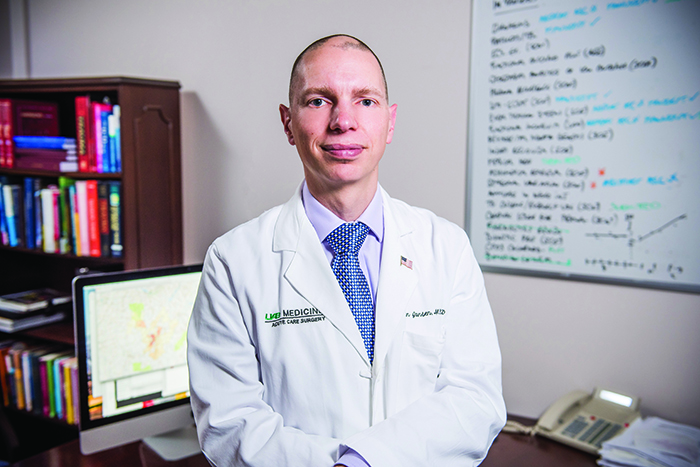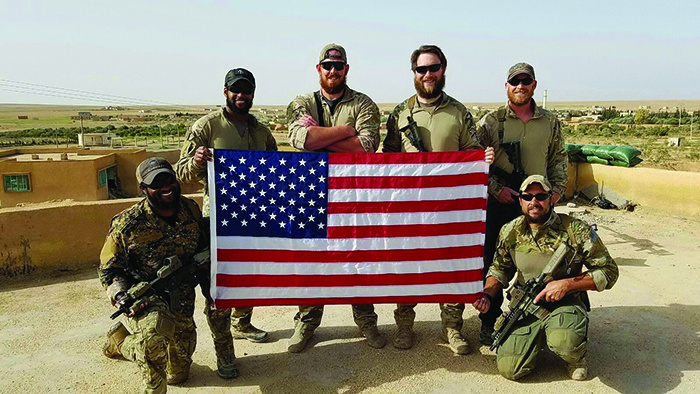 UAB is taking part in a national program that teaches the public how to help saves lives in a mass casualty event. A person lies before you bleeding on the ground. Panicked emotions flow as swiftly as the blood. Help is on the way, but will it arrive in time? It is possible, perhaps even likely, that your actions in the next few moments will determine whether this badly injured person lives or dies.
UAB is taking part in a national program that teaches the public how to help saves lives in a mass casualty event. A person lies before you bleeding on the ground. Panicked emotions flow as swiftly as the blood. Help is on the way, but will it arrive in time? It is possible, perhaps even likely, that your actions in the next few moments will determine whether this badly injured person lives or dies.
This is a nightmare scenario that, sadly, has become an all-too-common part of the American experience in recent years. Mass shootings have occurred with increasing regularity, particularly—and horrifically—at schools. In just the first month of this year, there were 12 school shooting incidents in the U.S. Then on Feb. 14, 17 people were killed in a devastating mass shooting at Marjory Stoneman Douglas High School in Parkland, Florida.
Beginning with the tragedy at Sandy Hook Elementary School in Newtown, Connecticut, where 20 children and six adults were fatally shot in December 2012, there has been an average of one school shooting per week. And this doesn’t include the near-daily occurrence of shootings at other public places, such as offices, churches, malls, and nightclubs.
“Unfortunately, that’s just a part of the world we live in right now,” says Jeffrey Kerby, M.D., Ph.D., director of the UAB Division of Acute Care Surgery in the School of Medicine and a former Air Force trauma surgeon. “We don’t have to accept it, but we do have to be prepared for it.”
UAB is working to increase that preparation by participating in the Stop the Bleed (STB) campaign, a national initiative organized by the American College of Surgeons (ACS). The program’s primary objective is to teach people how to control blood loss from a badly injured victim from any sort of incident—be it a shooting, explosion, car crash, etc.—in order to improve the victim’s chances of survival until medical professionals can take over. “What we’re trying to do is make this training as commonplace as CPR training, where everybody has the knowledge and the tools to prevent blood loss and save lives,” Kerby says.  Jeffrey Kerby is a former Air Force trauma surgeon and the director of UAB’s Acute Care Surgery Division. He spoke to The New York Times in March about what it’s like to try to repair wounds from military-style rifles. “You will typically see a small penetrating wound. Then you roll the patient over and you see a huge exit wound,” he told the reporters. Photo by Dustin Massey.
Jeffrey Kerby is a former Air Force trauma surgeon and the director of UAB’s Acute Care Surgery Division. He spoke to The New York Times in March about what it’s like to try to repair wounds from military-style rifles. “You will typically see a small penetrating wound. Then you roll the patient over and you see a huge exit wound,” he told the reporters. Photo by Dustin Massey.
STB emerged from the shock and trauma surrounding the Sandy Hook shooting. Hartford Hospital trauma surgeon Lenworth Jacobs Jr., M.D., led a committee formed in April 2013 that included representatives from the federal government, the National Security Council, the U.S. military, the Federal Bureau of Investigation, and a variety of emergency medical response organizations. The committee’s recommendations, called the Hartford Consensus, created a national policy on the best way to respond to mass casualty events. The committee stated that since uncontrolled bleeding is the most significant preventable cause of death in the pre-hospital environment (a person can bleed out in five to seven minutes), it is important for civilian bystanders to have the education and equipment needed to act as “immediate responders” and literally stop the bleeding.
“In a situation like Sandy Hook where you have an active shooter, EMS can’t get into the building until they’re sure it’s safe,” Kerby says. “When they analyzed [the victims], they realized that some of them had survivable injuries but had bled to death before they could be treated. So if there had been people inside the building who had the tools and training, they possibly could have stopped the bleeding and saved lives.”
UAB is the only ACS-designated Level I Trauma Center in Alabama, and Kerby serves on the ACS Committee on Trauma’s Executive Committee. It is natural, he says, that UAB take the lead on promoting and implementing the STB program. This involves offering training from both medical and military personnel, as well as providing STB kits that consist of tourniquets, compression bandages, gauze, hemostatic dressings, and protective gloves.
“We want to get the kits in every classroom in every school in the state of Alabama, and get every teacher trained in how to stop bleeding,” Kerby says. “You can’t just have a single kit for the entire school that is kept in the principal’s office. They have to be in the classrooms where the teachers can access them right away.
“Our first focus is on the schools, but we’ll provide the training to anybody who wants it. We’re trying to get kits in more public places. We want them in government buildings, sports facilities, malls—any public place where large groups of people gather. If you go to malls and airports, you see defibrillators hanging on the walls. We want Stop the Bleed kits right next to those, and to have as many people in the area trained as possible.”
Battle Tested
 Jan Jansen served in the British Army as a reservist and was awarded a Queen’s Commendation for his service in Afghanistan. As the Division of Acute Care Surgery’s director of research, he is working to identify geographic areas where making the Stop the Bleed intervention more widely available might help save lives. Photo by Nik Layman.To many participants’ surprise, the STB training takes only about 30-40 minutes to complete and is relatively easy to comprehend, even for those with no prior medical training. “Many people think that trauma surgery is something really sophisticated, but most of it is very straightforward,” says Jan Jansen, MBBS, Ph.D., director of research in the UAB Division of Acute Care Surgery. “Put pressure where the blood is spurting out or apply a tourniquet. It’s really as simple as that. But for people who don’t have the background, there is an understandable reluctance and anxiety when faced with somebody who has visible injuries and is bleeding. They think they need a professional.
Jan Jansen served in the British Army as a reservist and was awarded a Queen’s Commendation for his service in Afghanistan. As the Division of Acute Care Surgery’s director of research, he is working to identify geographic areas where making the Stop the Bleed intervention more widely available might help save lives. Photo by Nik Layman.To many participants’ surprise, the STB training takes only about 30-40 minutes to complete and is relatively easy to comprehend, even for those with no prior medical training. “Many people think that trauma surgery is something really sophisticated, but most of it is very straightforward,” says Jan Jansen, MBBS, Ph.D., director of research in the UAB Division of Acute Care Surgery. “Put pressure where the blood is spurting out or apply a tourniquet. It’s really as simple as that. But for people who don’t have the background, there is an understandable reluctance and anxiety when faced with somebody who has visible injuries and is bleeding. They think they need a professional.
“The message we’re trying to get across is that this isn’t that complicated. If there is visible bleeding, you can stop it with direct pressure or a tourniquet. You can’t really do a lot wrong there.”
A typical STB training session begins with a brief slide presentation explaining how best to curtail bleeding through the use of tourniquets or other forms of pressure. Then participants are divided into smaller groups of three or four people per instructor. They are walked through the process of applying pressure, packing a wound, and using a tourniquet. These steps usually are first demonstrated on mannequins, and then the tourniquets are applied to the instructor in order for trainees to get the true feel of working on a person. This is followed by a brief wrap-up discussion to answer any remaining questions.
“It’s a lot like CPR training,” says Homewood High School math instructor and cross country coach Lars Porter, who took part in an STB session along with about 100 other teachers at the school. “They’re just giving you the basic instructions. They’re not asking you to be doctors; they’re asking you to simply put a tight belt around someone’s arm.” Left to right: Christie Morman and Lars Porter are teachers at Homewood High School who took part in a Stop the Bleed training session conducted by UAB Acute Care Surgery faculty and staff. They say they feel more secure in their ability to act to help save lives if they ever find themselves in a situation like a school shooting. Photo by Dustin Massey.
Left to right: Christie Morman and Lars Porter are teachers at Homewood High School who took part in a Stop the Bleed training session conducted by UAB Acute Care Surgery faculty and staff. They say they feel more secure in their ability to act to help save lives if they ever find themselves in a situation like a school shooting. Photo by Dustin Massey.
The knowledge that comes from an STB session enables participants to gain the confidence to do something helpful if an emergency situation arises. “Having knowledge is the best way to be prepared,” Homewood social studies teacher Christie Morman says. “If you’re prepared to some extent, you can at least focus on what you have to do, instead of panicking and not even knowing what the first step is. Doing something to at least give that person a chance is better than sitting there with no idea.”
“Now I feel like not only could I do it, but I could turn around and tell a student how to do it, and they would get it,” she says. “I came out of the training thinking that if I had to teach someone how to do this very quickly, I could. It makes me feel better prepared for a potential situation.”
The training is also used to dispel the widely held misconception that the use of tourniquets often leads to amputations. It is true that if limbs go too long without blood flow and function cannot be restored, an amputation might be necessary. “However, you can leave a tourniquet on for up to two hours and not lose the limb,” Kerby notes. Moreover, in a worst-case scenario, many would consider it better to lose a limb than to lose a life.
Still, tourniquets were avoided for decades, even in battlefield situations where there often was no way for an injured solider to receive immediate medical attention. That began to change in the early 2000s when studies conducted during the wars in Iraq and Afghanistan found that the use of tourniquets greatly improved an injured soldier’s chance of survival with no increase in amputations.
“There has been a sea change in thinking about tourniquets,” says Jansen, who served as a reservist in the British Army. “The No. 1 cause of preventable death on the battlefield was hemorrhage. Many of the soldiers who died did so before they could get to a medical facility [approximately 90 percent, according to a 2011 article from the Journal of the American Medical Association].
“For a long time, the treatment priorities had always been A-B-C—first look after the airway, then the breathing, then circulation, which includes stopping blood loss. But it was recognized that sometimes blood loss in these modern conflicts was so catastrophic that it had to be dealt with first.”
Homefront Heroes
Jansen says the paradigm shift in battlefield medicine, where the top priority now is to stop hemorrhage, has carried over to civilian practice. Lessons learned on the battlefield often can be used in civilian trauma care, which is one of the reasons UAB has hosted Air Force Special Operations Surgical Teams (SOSTs) since 2010. Each six-person unit—composed of a trauma surgeon, emergency physician, nurse anesthetist, surgical scrub technician, critical care nurse, and a respiratory technician—is designed to offer mobile medical support for wounded American military personnel and the local civilian population during combat operations, packing everything they need into six backpacks. UAB hosts three, six-man SOSTs, who rotate on deployments that typically last about four months.
Lt. Col. Benjamin Mitchell, M.D., an SOST leader, was awarded the 2017 Heroes of Military Medicine Award by the Henry M. Jackson Foundation for the Advancement of Military Medicine this past summer. In addition, a UAB-based SOST received Bronze Star Medals for their actions during a 2016 deployment to the Middle East during a Feb. 13 ceremony. Over the course of two weeks during summer 2016, the team treated 750 patients, responded to 19 mass-casualty events, conducted 16 life-saving surgeries, and treated victims of a chemical weapon attack.
When not deployed overseas, SOST members hone their skills by working in UAB Hospital’s Level 1 trauma center and assisting in Stop the Bleed training. “They are a high-functioning group that goes to a lot of high-impact areas across the globe,” Kerby says. “They have the expertise and knowledge, and that’s well received by the community when we go out to do this training. They know they’re being trained by people who have experience in these types of casualty situations, and that heightens the impact of what they’re learning.”
 Maj. Ben Von Schweinitz and members of one of the Air Force Special Operations Surgical Teams based at UAB are pictured on deployment in the Middle East. These six-person teams are composed of a variety of health professionals who offer medical support during combat operations. SOST members have helped lead Stop the Bleed teacher trainings at schools across the Birmingham area.
Maj. Ben Von Schweinitz and members of one of the Air Force Special Operations Surgical Teams based at UAB are pictured on deployment in the Middle East. These six-person teams are composed of a variety of health professionals who offer medical support during combat operations. SOST members have helped lead Stop the Bleed teacher trainings at schools across the Birmingham area.
Indeed, Maj. Ben Von Schweinitz, M.D., an SOST emergency medicine physician, says his unit applied more than 500 tourniquets during a recent deployment. And he says most of their techniques can be used just as effectively among the civilian population.
“Injuries from gunshots and bombs originally were just seen in the military. Unfortunately, what has happened is those injuries are showing up in the civilian setting in places where large amounts of people will gather,” says Von Schweinitz, a native of South Carolina who has been at UAB since 2015. “The military has the expertise to deal with these kinds of injuries that the civilian side really hadn’t seen. What we’re doing with Stop the Bleed is showing people that these techniques are not that hard to learn, and they can potentially save many lives.”
Of course, practicing such tactics on a mannequin or a healthy individual in a controlled environment is completely different from dealing with a real person who is suffering from traumatic blood loss in a chaotic emergency situation. But while there is no way for a civilian to truly prepare for such a situation, Von Schweinitz says the STB training can help.
“The way to get over that feeling of panic is to turn it into a muscle-memory task,” he says. “That way, you’re more likely in a stressful situation to focus on the task, and remember how the tourniquet is used and how it goes on.”
In addition to the training, UAB is conducting research on how to make the STB campaign more effective. In particular, Jansen has been working with hospital data and the medical examiner’s office to identify geographic areas where STB interventions possibly could have helped saved lives.
“With Stop the Bleed, people think of a shooting or another mass casualty event, but these events are fortunately not daily occurrences,” Jansen says. “What we’re interested in is to see if this can be useful in day-to-day life.
“We’re examining data about patients who came into UAB Hospital and patients who never made it because they died before medical assistance was available. We’re trying to see where patients would benefit from having these interventions more widely available.”
If Kerby has his way, geography eventually won’t matter because STB training and kits will be available nearly everywhere. UAB is promoting the program on social media through the hashtag #EveryClassroomEverySchool, and through events such as a Facebook Live demonstration in February that highlighted bleeding-control techniques.
Kerby hopes members of the public will help expand the program’s reach through philanthropic support to buy and distribute more STB kits.
“We’re also trying to arrange a day at the state capitol to train our lawmakers and educate them about the program,” Kerby says. “We want to train people to go out into their communities and organize their own training efforts. It doesn’t have to just be us. This can be a grassroots campaign.”
To learn more about giving to support the Stop the Bleed program, contact Jennifer Foster at 205-934-2875 or jenfost1@uab.edu.
By Cary Estes
Illustration by Kristin Farmer